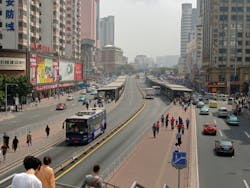I’ve attended quite a few conferences that focus on high-speed rail. And one of the things that attendees had lamented on was the misuse of the phrase “high-speed rail.” Rail line improvements and faster trains were being implemented and planned in various parts of the country. These were being coined “high-speed rail” by politicians, the media and even the organizations operating them.
The one problem, they weren’t actual HSR. While they were calling them high-speed rail thinking that would get people excited and supportive, all it was doing was making a lot of people cynical.
Slightly faster service, at-grade crossings, it’s not HSR and it has made people question what they can believe from us. It has also given fuel to the detractors to point out what we’re not delivering.
And that’s what continues to happen with bus rapid transit. BRT is being used to describe new buses on a route that has less stops. And maybe even fancier stops.
When we did an international BRT update a few years ago, what’s being done in other countries is like a subway on rubber tires. If there’s a car accident on the highways, the BRT will have its same running time as it’s not impacted by what’s happening with the cars. And whether traffic congestion grows by 10 percent or 50 percent in the next 25 years in those cities, the BRT system will still have the same running times.
The more “BRT” is used to describe express service, the more diluted the term gets.
There are three systems we take a look at in this issue that have some common features and some differences. Some creative branding highlights the faster, more frequent service they have that utilizes the latest technologies and some dedicated right-of-ways to move people efficiently.
Each location had different challenges and constraints that needed to be met and the agencies share what solution worked best for the area. With more BRT corridors opening later this year, we will continue to watch what systems are doing here and abroad and how the the term BRT is used.



